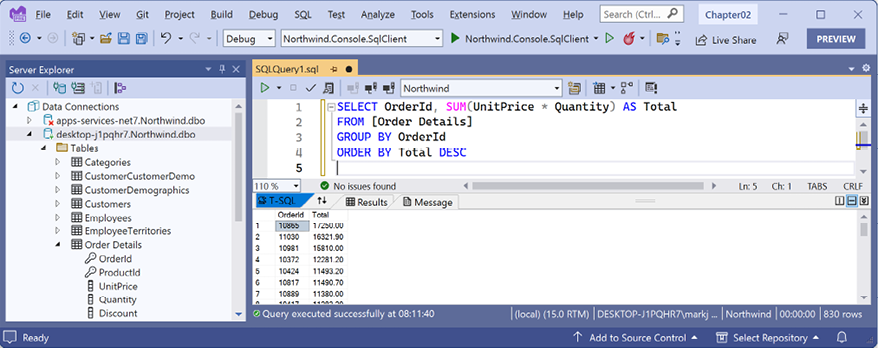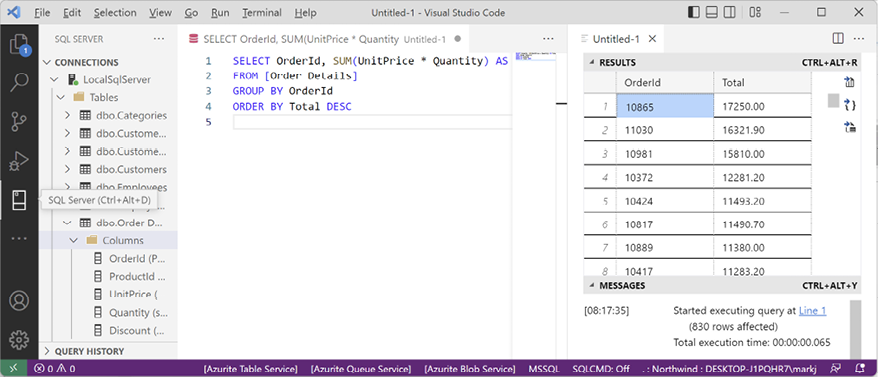Managing data with Transact-SQL
Transact-SQL (T-SQL) is SQL Server’s dialect of Structured Query Language (SQL). Some pronounce it tee-sequel, others tee-es-queue-el.
Unlike C#, T-SQL is not case-sensitive; for example, you can use int or INT to specify the 32-bit integer data type, and you can use SELECT or select to start a query expression. Text stored in SQL Server can be treated as case-sensitive or not depending on configuration.
The complete reference for T-SQL is found at the following link: https://learn.microsoft.com/en-us/sql/t-sql/language-reference.
T-SQL data types
T-SQL has data types that are used for columns, variables, parameters, and so on.
|
Category |
Examples |
|
Numbers |
|
|
Date and time |
|
|
Text |
|
|
Binary |
|
|
Other |
|
T-SQL also has support for spatial geometry and geography types.
Documenting with comments
To comment out the rest of a line, use -- which is the equivalent of //.
To comment out a block, use /* and the start and */ at the end, just like in C#.
Declaring variables
Local variable names are prefixed with @ and they are defined using SET, SELECT, or DECLARE, as shown in the following code:
DECLARE @WholeNumber INT; -- Declare a variable and specify its type.
SET @WholeNumber = 3; -- Set the variable to a literal value.
SET @WholeNumber = @WholeNumber + 1; -- Increment the variable.
SELECT @WholeNumber = COUNT(*) FROM Employees; -- Set to the number of employees.
SELECT @WholeNumber = EmployeeId FROM Employees WHERE FirstName = 'Janet';
Global variables are prefixed with @@. For example, @@ROWCOUNT is a context-dependent value that returns the number of rows affected by a statement executed within the current scope, for example, the number of rows updated or deleted.
Specifying data types
Most types have a fixed size. For example, an int uses four bytes, a smallint uses two bytes, and a tinyint uses one byte.
For text and binary types, you can either specify a type prefixed with var or nvar (meaning variable size) that will automatically change its size based on its current value up to a maximum, as shown in the following example: varchar(40); or you can specify a fixed number of characters that will always be allocated, as shown in the following example: char(40).
For text types, the n prefix indicates Unicode, meaning it will use two bytes per character. Text types not prefixed with n use one byte per character.
Controlling flow
T-SQL has similar flow control keywords as C#, for example, BREAK, CONTINUE, GOTO, IF...ELSE, CASE, THROW, TRY...CATCH, WHILE, and RETURN. The main difference is the use of BEGIN and END to indicate the start and end of a block, the equivalent of curly braces in C#.
Operators
T-SQL has similar operators as C#, for example, = (assignment), +, -, *, /, %, <, >, <=, ==, !=, &, |, ^, and so on. It has logical operators like AND, OR, NOT, and LINQ-like operators like ANY, ALL, SOME, EXISTS, BETWEEN, and IN.
LIKE is used for text pattern matching. The pattern can use % for any number of characters. The pattern can use _ for a single character. The pattern can use [] to specify a range and set of allowed characters, for example, [0-9A-Z.-,].
If a table or column name contains spaces, then you must surround the name in square brackets like [Order Details]. The SQL scripts to create the Northwind database include the command set quoted_identifier on, so you can also use double-quotes like "Order Details". Single quotes are used for literal text like 'USA'.
Data Manipulation Language (DML)
DML is used to query and change data.
The most common statement in DML is SELECT, which is used to retrieve data from one or more tables. SELECT is extremely complicated because it is so powerful. This book is not about learning T-SQL, so the quickest way to get a feel for SELECT is to see some examples, as shown in the following table:
|
Example |
Description |
|
|
Get all columns of all the employees. |
|
|
Get the first and last name columns of all employees. |
|
|
Give an alias for the table name. |
|
|
Give an alias for the table name. |
|
|
Give an alias for the column name. |
|
|
Filter the results to only include employees in the USA. |
|
|
Get a list of countries without duplicates. |
|
|
Calculate a subtotal for each order detail row. |
|
|
Calculate a total for each order and sort with the largest order value at the top. |
|
|
Return all the company names of all customers and suppliers. |
|
|
Match every category with every product using a Cartesian join and output their names (not what you normally want!) 616 rows (8 categories x 77 products). |
|
|
Match each product with its category using a 77 rows. |
|
|
Match each product with its category using an 77 rows. |
You can read the full documentation for SELECT at the following link: https://docs.microsoft.com/en-us/sql/t-sql/queries/select-transact-sql.
Use your favorite database querying tool, like Visual Studio Server Explorer or Visual Studio Code’s mssql extension, to connect to your Northwind database and try out some of the queries above, as shown in Figure 2.10 and Figure 2.11:

Figure 2.10: Executing T-SQL queries using Visual Studio’s Server Explorer

Figure 2.11: Executing T-SQL queries using Visual Studio Code’s mssql extension
DML for adding, updating, and deleting data
DML statements for adding, updating, and deleting data include:
|
Example |
Description |
|
|
Add a new row into the |
|
|
Update my employee row to set my |
|
|
Delete my employee row. |
|
|
Delete all rows in the |
|
|
Delete all rows in the |
The above examples use the Employees table in the Northwind database. That table has referential integrity constraints that mean that, for example, deleting all rows in the table cannot happen, because every employee has related data in other tables like Orders.
Data Definition Language (DDL)
DDL statements change the structure of the database, including creating new objects like tables, functions, and stored procedures. The following table shows some examples of DDL statements to give you an idea, but the examples are simple and cannot be executed within the Northwind database.
|
Example |
Description |
|
|
Create a table to store shippers. |
|
|
Add a column to a table. |
|
|
Add a non-clustered index for a column in a table. |
|
|
Change an aggregate index with multiple columns and control the sort order. |
|
|
Delete the |
|
|
Delete the |
|
|
Check if a table exists. The |
























































